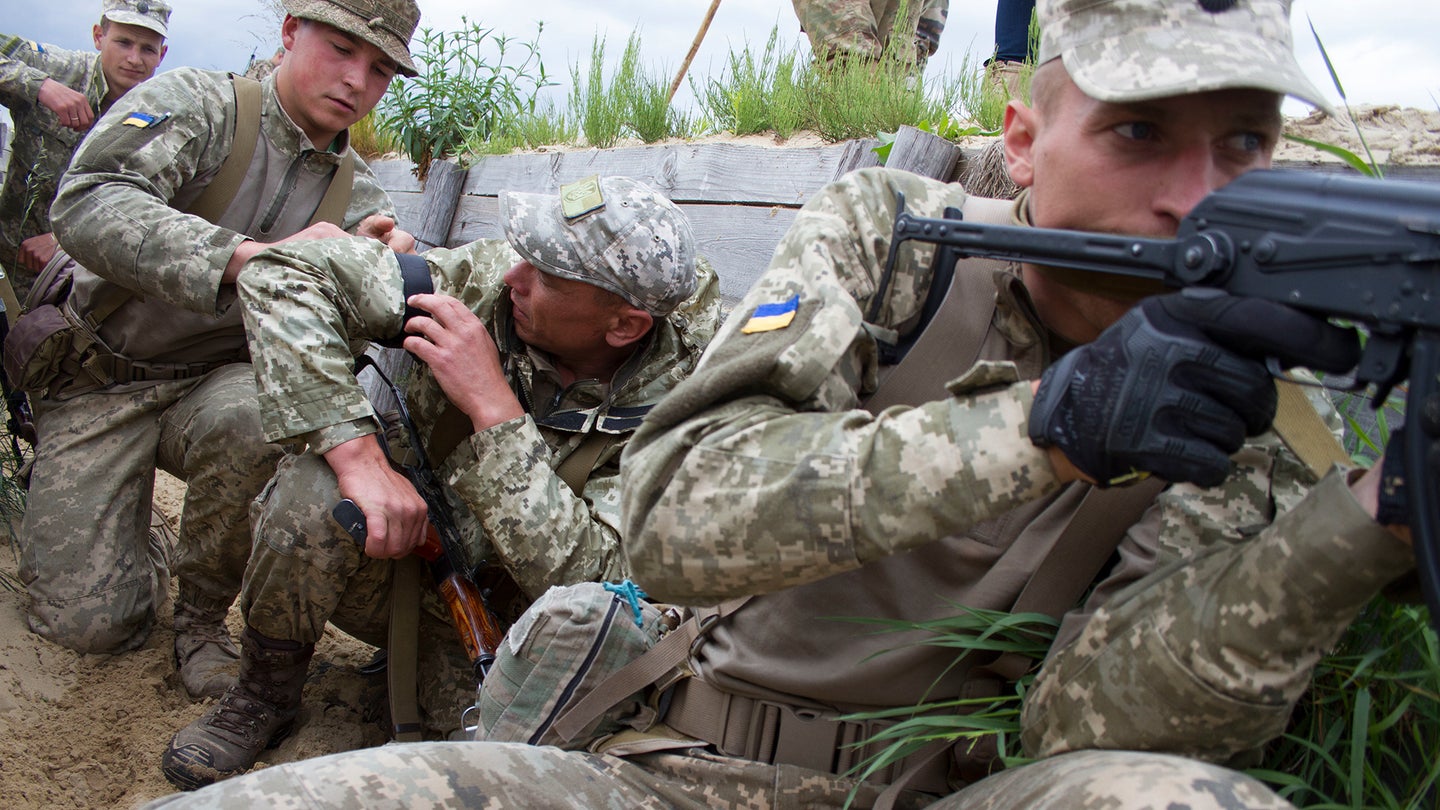
For 18 months, Russia’s invasion of Ukraine has been fought largely from the ground. Neither Russia nor Ukraine has been able to establish air superiority, or the ability to completely rule the sky at the other’s expense. While Ukraine is working to gradually build up a new air force using NATO-model fighters like the F-16 (which nations including Denmark and the Netherlands have pledged to the country), it is also using a range of drones to drop death from the sky. On August 19, the Ukrainian Ministry of Defense announced a small new armed drone for military use: the SkyKnight.
The announcement of the new UAV was posted to the Ministry of Defense’s Telegram account, and features an image of the SkyKnight drone. The vehicle is compact, and features four limbs like a common quadcopter, but each limb sports two rotors, making the drone an octocopter. A sensor is fitted on the front of the drone, with a camera facing forwards, and what appears to be batteries are strapped, in an unusual configuration, to the top of the drone’s hull. Underneath it holds a 2.5 kg (5.5 lbs) bomb. That’s between three and five times as heavy as a hand grenade, and would be a large explosive for a drone of this size.
“This can be used against stationary and moving targets – anything from tanks, armored vehicles, artillery and other systems, to infantry units on the move and in trenches, and against any target that is identified as a Russian military one,” says Samuel Bendett, an analyst at the Center for Naval Analysis and adjunct senior fellow at the Center for New American Security. “This payload can be effective and devastating against infantry units, as evidenced from multiple videos of similar attacks by quadcopters.”
Before the massive invasion of Ukraine in February 2022, the country fought a long, though more geographically confined, war against Russian-backed separatists in the Donbas of Eastern Ukraine. Using quadcopters as bombers was a regular occurance in that war, like when in 2018 Ukrainian forces used a DJI Mavic quadcopter to drop a bomb on trenches. While the Mavic was not built for war, it is a simple and easy to use machine, which could be modified in the field to carry a small explosive and a release claw. Paired with the drone’s cameras and human operators watching from a control screen, soldiers could get a bird’s eye view of their human targets, and then attack from above.
This tactic persisted in the larger war from February 2022, where small drones joined medium and larger drones in the arsenals of both nations fighting. The war in Ukraine is hardly the first war to see extensive use of drones, but none so far have matched it in sheer scale.
“Never before have so many drones been used in a military confrontation,” writes Ulrike Franke, a senior policy fellow at the European Council on Foreign Relations. “Many, possibly the majority, of the drones used by Ukrainian forces were originally designed for commercial purposes or for hobbyists.”
The SkyKnight is described as domestically produced, a production of the present Ukrainian industry built for this specific war. It appears to share parts in common from the broader hobbyist drone market, and its assembly, complete with strapped-on batteries and exposed wires (at least according to how it’s depicted on Telegram), speaks to ease of assembly over finicky obsession with form.
In the announcement of the SkyKnight, the Ministry of Defence says that if the pilot has any familiarity with DJI or Autel drones, which stabilize themselves in flight, then the pilot can learn to fly the SkyKnight in about a week.
“DJI and Autel are a staple [Uncrewed Aerial Vehicle] across the Ukrainian military, with many thousands fielded since the start of the Russian invasion,” says Bendett. “DJI especially as a go-to drone for ISR, target tracking, artillery spotting and light combat missions. Ukrainian forces and drone operators have amassed a lot of experience flying these Chinese-made drones.”
Domestic manufacture is important, not just because of the shorter supply lines, but because DJI’s response to the conflict has been to ban the sale of its drone to Ukraine and Russia.
“The Chinese manufacturer DJI produces most of these systems,” writes Franke. “It officially suspended operations in Ukraine and Russia a few weeks into the war, but its drones, most notably the Mavic type, remain among the most used and most sought-after systems.”
By making its own self-detonating drone weapons, Ukraine is able to use the drones as a direct weapon, which can attack from above and is hard to see or stop. In a war where soldiers describe fighting without quadcopters as being “like blind kittens,” a flying camera with a bomb attached makes soldiers deadly, at greater range, and in new ways.
Beyond the airframe and remote control, the Ministry of Defense boasts that the SkyKnight has an automatic flight mode, and can continue to fly towards a target selected by the operator even if the operator loses communication with the drone.
“Ukraine is investing a lot of resources in domestic combat drone production to meet the challenge from the Russian military that is increasingly fielding more quadcopter and FPV-type drones,” says Bendett. “This SkyKnight needs to be manufactured in sufficient quantities to start making a difference on the battlefield.”
The post Ukraine claims it built a battle drone called SkyKnight that can carry a bomb appeared first on Popular Science.
Articles may contain affiliate links which enable us to share in the revenue of any purchases made.
from | Popular Science https://ift.tt/3mgZ9MB



0 Comments